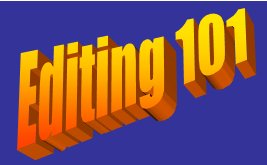Yesterday, I talked about the difference between revisions and editing and about what an editor’s role is. Today I’m going to go a little bit more in depth, and show you how content editing differs from copy editing.
When someone edits for content, they are trying to communicate what they envision your audience to be and what story you are trying to tell. When someone edits for grammar, word usage or punctuation, they are using copy editing skills to ensure that your project or story is readable. There are several different naming conventions that might apply for the role of editor (proofreading, content editor, text editor, line editor) but, for the sake of simplicity, I’m utilizing “content” and “copy” here.
Many experienced content editors will talk to you about your work in general without ever pulling up the specific words you write in front of you. Why? Good content editors trust that a writer will do their job to massage the voice according to the overall goal of the piece.
Sometimes, it’s not the words put down on the page that an editor has a challenge with but the strategy behind the words. In that case, consistency is key to ensuring predictable submissions: that is both the responsibility of the content editor to communicate their needs, and the writer to deliver them through the words they choose.
Read More…

 Congratulations! You’ve just finished your project or story. Now what?
Congratulations! You’ve just finished your project or story. Now what?